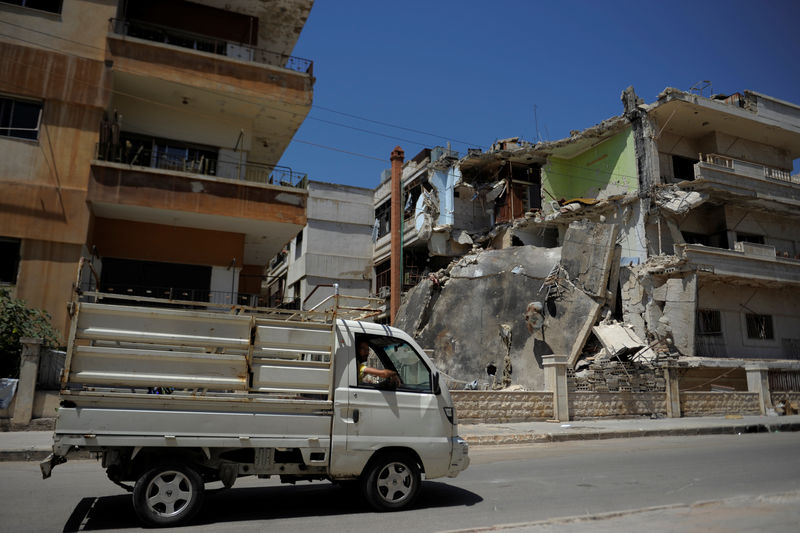By Dahlia Nehme
HOMS, Syria (Reuters) - President Bashar al-Assad's victory in Homs is still evident in the rubble of Baba Amr, a former symbol of the rebellion where five years later only a handful of people live among ruins.
Across town, the bustling markets of the pro-Assad district of Zahraa show which side came out on top in the battle for what was once Syria's third biggest city.
The stark divide between who won and who lost, clearly visible when Reuters visited the tightly controlled Baba Amr neighbourhood, illustrates the price of defying the Assad government.
Homs was one of the earliest centres of the rebellion against Assad, and the first city where it was put down with overwhelming force.
Rebels were driven out of Baba Amr in 2012. Two years later they were forced from the adjacent Old City. The last rebel-held area on the city outskirts - the Waer district - was recaptured earlier this year.
Though years have passed since the government recaptured Baba Amr and the Old City, there has been little reconstruction.
There are few signs of life, with depopulated neighbourhoods pointing to the lasting damage inflicted on a city where the war took on a strongly sectarian character, pitting pro-Assad Alawites against Sunnis who fled in large numbers, shifting the demographics of the city against them.
Those who stayed recount the loss of relatives killed in fighting, detained by security forces, or abducted in tit-for-tat kidnappings. Then there are the missing: those whose fates are entirely unknown.
DETAINED, MARTYRED
"Two of my sons are detained, another was martyred, one is in Lebanon and another is in Libya," said Faisal al-Fitrawi, 71, a resident of Baba Amr who left at the start of the fighting and returned once it had been retaken by the government.
He is one of very few people to come back to the area since it was recaptured by the government.
A carpenter by trade, Fitrawi grows vegetables on the central reservation of the deserted road outside his sparsely furnished apartment. Broken windows have been boarded up instead of reglazed: building materials are in short supply.
The government has kept a tight rein on what - and who - can enter Baba Amr. Reuters journalists visited the area accompanied by a government soldier and an information ministry official.
The handful of people living nearby include those displaced from other parts of Syria, resettled in Baba Amr's empty homes.
The government's recapture of the Old City of Homs provided a model for its tactics against rebels. A long siege and bombardment led to a negotiated withdrawal of rebels to other insurgent-held areas.
Similar methods were used against rebel areas of eastern Aleppo recaptured last year, and in opposition strongholds around Damascus that have fallen over the last year.
The population of Homs was more than 800,000 prior to the war. It currently stands at 472,000, 192,000 of them internally displaced people who moved into Homs during the war, according to U.N. figures obtained by Reuters. Sunnis represent the bulk of those who fled.
The destruction of the old commercial centre of Homs created an economic boom in the working class district of Zahraa, a predominantly Alawite area on the eastern outskirts that is loyal to the government.
LARGELY UNSCATHED
Largely unscathed by bombardment, life in Zahraa rappears normal set against the deserted and devastated areas of central Homs.
"After the central market shut, the traders came here and opened big shops, and economic situation improved," said Ahmed Kasser Al-Ali, the local MP. "The main streets in Zahraa flourished."
The war has however exacted a heavy toll. Eighty percent of the youth of Zahraa are in Assad's forces.
"You can't walk down a street without finding a person suffering disability," Ali said. "Those who aren't wounded are at the front."
The dead stare down from posters commemorating them as martyrs, alongside pictures of Assad and his father, Hafez al-Assad, known in Zahraa as "our father".
Karima Shaaban, 57, wears black in mourning for the two sons she has lost during the war.
"What upsets me is that when my son was martyred we went to the newly opened cemetery and there were 13 graves. Now you should see it," she said, wearing a necklace decorated with a picture of her son.
The governor of Homs, Talal Barazi, has grand plans to rebuild the city. Wrecked areas such as Baba Amr have been completely replanned. Financing is to come from Syrian state banks and, he hopes, investments from allied states and Syrians overseas.
With the Waer district back in government hands, Barazi has declared Homs completely secure. "The circumstances are now very suitable for the return of all the people," he said.
Returnees must however be vetted.
The process requires proof of property ownership and a green light from the police who check to see if returnees are wanted for any offence "be it security or criminal", Barazi said.
Critics say this vetting deters many from applying, meaning only loyalists come back.
Abdel Nasser Al-Sheikh Fattouh, head of the Homs chamber of commerce, wants authorities to drop the security measures to encourage people to come back.

"We need a whole package of exceptional decisions to encourage people to return during these exceptional times," he said. "We want officials who dare to make these decisions."